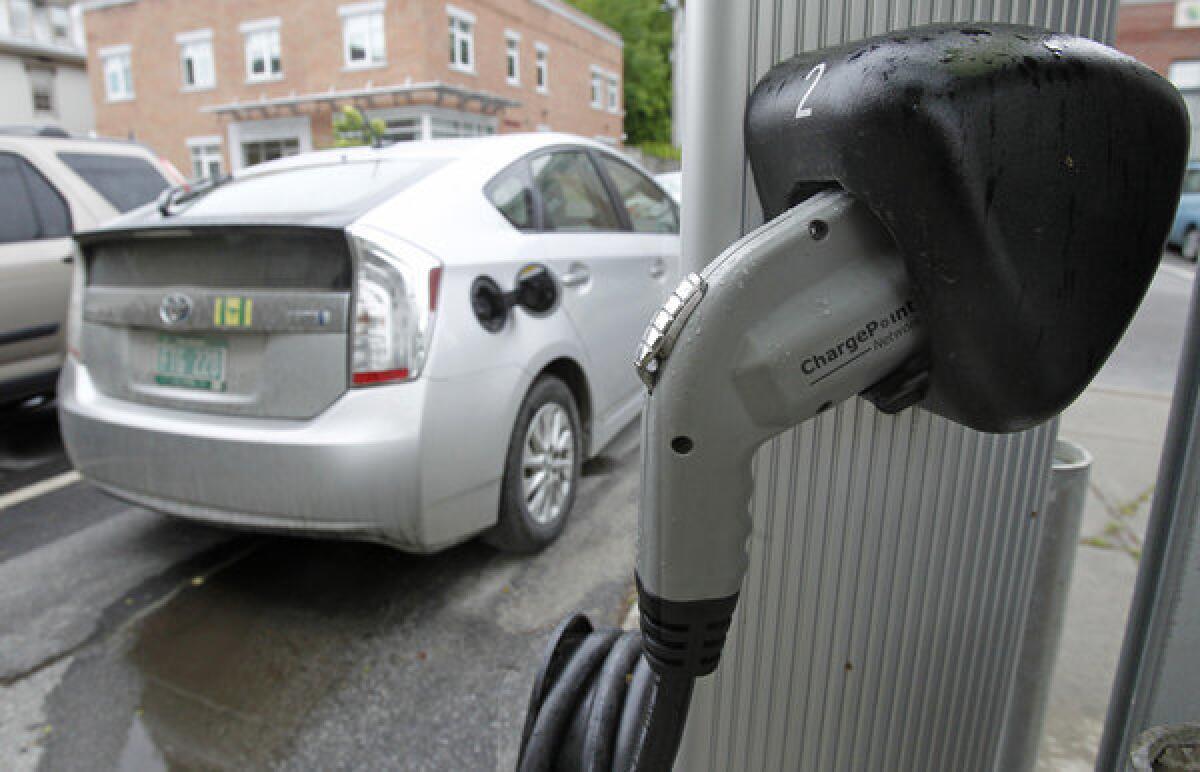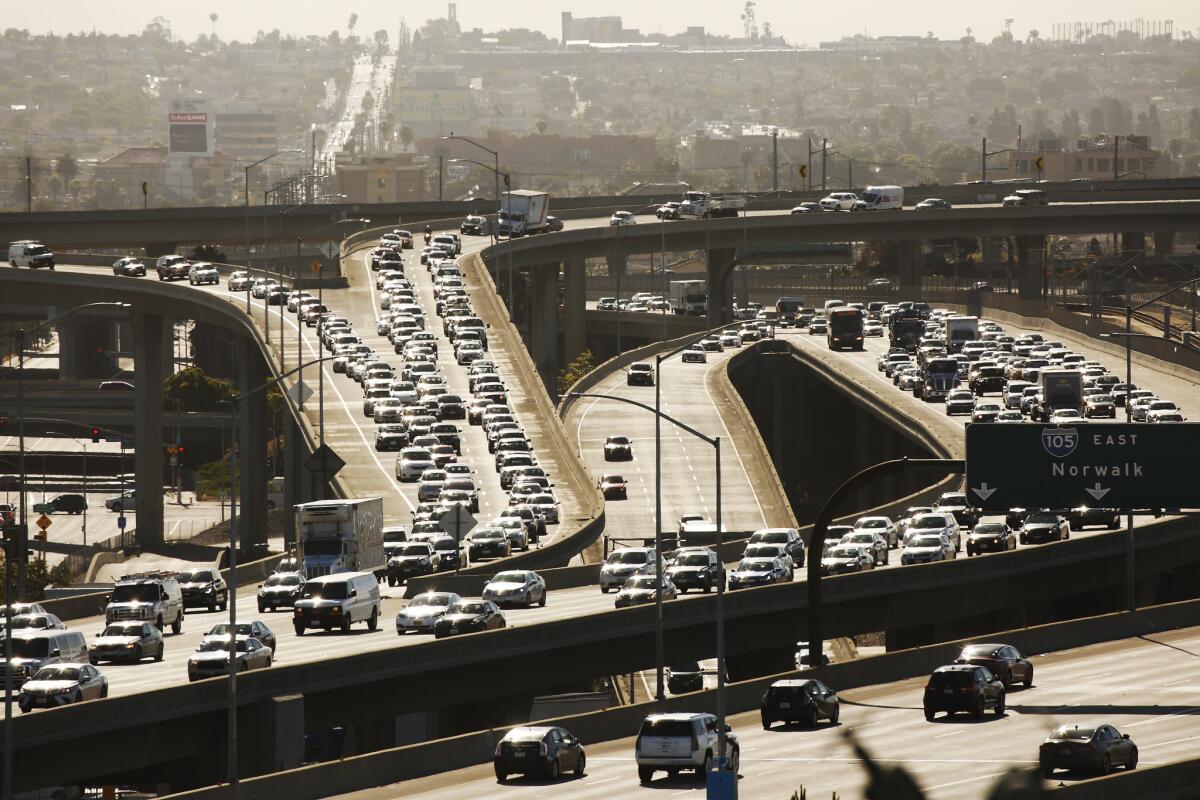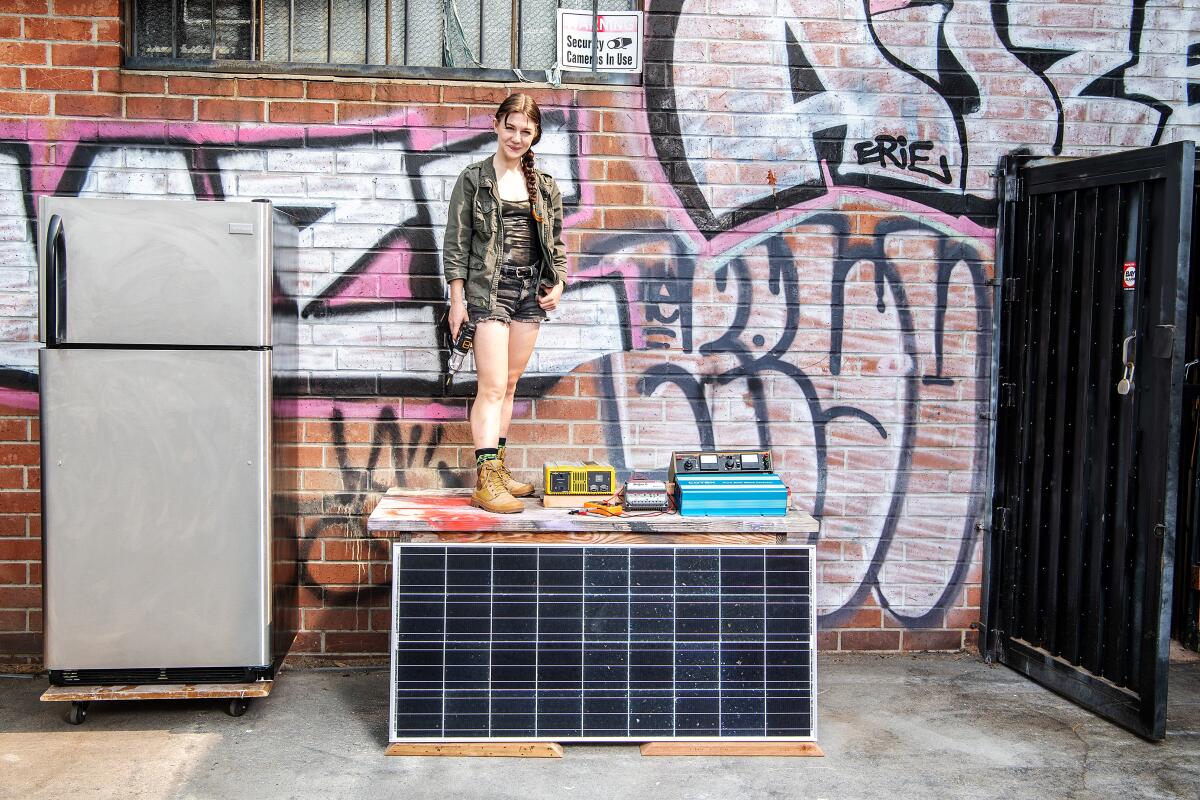Boiling Point: No more gas-powered cars? Why California’s shift to zero-emission vehicles is ‘huge’

- Share via
Good morning. I’m Tony Barboza, and I’m filling in for Sammy Roth, who has been on vacation and will be back next week.
Living in Southern California, I spend a lot of time on the freeway behind the wheel of my Subaru Impreza — or at least I did before the pandemic. As I watch the miles tick upward on my odometer, I’ve also felt guilty about the pollution my white sedan is spewing into the air.
Now I’m thinking it could be the last gas-powered car I own.
That’s because of an executive order Gov. Gavin Newsom issued last week to require that all new passenger vehicles sold in California be zero-emission by 2035. The announcement came after a summer in which California experienced record-shattering heat waves and wildfires and weeks of horribly smoky air, which motivated Newsom to pledge “giant leaps forward” in fighting climate change.
Phasing out gas-fueled vehicles is a huge shift for the nation’s car capital. It’s also a logical next step for a state that has long struggled with air pollution, and increasingly, the effects of global warming.
For perspective, I called Julie Cerqueira, executive director of the U.S. Climate Alliance, a coalition of 25 states that are working to reduce greenhouse gas emissions and advance the goals of the international Paris climate accord, which President Trump has disavowed. Cerqueira previously worked in the U.S. State Department, from 2014 to 2017, as a senior advisor to the special envoy for climate change. Our conversation has been edited and condensed.
How does this 15-year timeline fit into the Paris accord and its goal to keep the global rise in temperatures below 2 degrees Celsius?
What’s really important about this announcement is that the transportation sector continues to be our largest source of greenhouse gases in the United States. And despite many of the regulations and incentives that are out there, we are really failing to adequately address transportation emissions. The science has been telling us we really only have 10, 20 years to start to make a major dent in our CO2 emissions if we actually want to stay within a 1.5-degree or 2-degree temperature change between now and 2100.
How significant is this move nationally?
You’re talking about the largest state in the U.S., the fifth largest economy in the world, reducing a third of its greenhouse gas emissions. That’s huge. You’re going to create a huge market in California. But it’s also going to stimulate new jobs and drive more investment. Because you’re also increasing the volume of production for those vehicles, and the variety of zero-emission vehicles that are available. You start to bring down the cost of those technologies, and that starts to bleed into other states.

How does Gov. Newsom’s target compare to other countries?
California’s announcement aligns with what some of the most progressive countries in the world are doing to also reduce their transportation emissions. You see countries like the UK and Norway, others in the EU, that are also looking at phasing out the internal combustion engine for passenger vehicles. But there’s obviously a major disconnect right now between what the states and other countries are doing and where the U.S. federal government is.
California’s fight with the Trump administration over auto emissions could end up in the Supreme Court. How much will the November election determine whether a new zero-emission vehicle mandate can actually move forward?
It’s pretty significant. A Biden administration, I would assume, would not continue to pursue a case against California in trying to revoke California’s waiver, which is what allows them to put in place emissions regulations. And a Biden administration would probably come to the table with California and the auto industry to have more stringent standards rather than trying to roll back the Obama-era standards.
Newsom’s order is getting pushback from automakers and the oil industry, who say a mandate will increase costs to consumers. Can we really force people out of gas-guzzling trucks and SUVs and into electric vehicles?
We have so few options right now. So many more vehicles are sold in Europe, for example, than we have available in the U.S., because they have more stringent standards. So I think if you were to present Americans with SUVs and trucks that are cleaner, that are more efficient, that have price parity, that have higher performance standards, why wouldn’t you choose that over a gas-powered vehicle?
U.S. Environmental Protection Agency Administrator Andrew Wheeler said that “one state can’t make that big of a difference” in reducing greenhouse gas emissions.
One state has already made a big difference. If you look at the efficiency of vehicles across the country today, much of that has been driven by California. They were able to set more stringent standards for tailpipe emissions, which then helped motivate the U.S federal government. With zero-emission vehicles, we need to move faster, which I’m hoping this executive order will help us to do.
Others argue a 15-year timeline isn’t all that radical. The Union of Concerned Scientists calculated that under Newsom’s plan, gas-fueled vehicles could still make up almost half the cars on the road in 2035.
That’s a valid criticism. I mean, you see some countries like Norway that have an accelerated timeline. And there’s complementary programs that we’ve seen in the past, like Cash for Clunkers, that are intended to accelerate the turnover in some of these older vehicles. But you always are balancing what is the most ambitious thing that you can do with what is politically feasible.

Environmental justice groups criticized Gov. Newsom for addressing fossil fuel consumption without doing more to restrict its production. How do you ensure that communities of color near oil drilling sites and other pollution hot spots aren’t left behind?
Another part of the executive order that people aren’t talking as much about is the electrification of heavy-duty vehicles, which are really dirty freight vehicles that tend to be passing through corridors where there’s a lot of disadvantaged communities. So this executive order is also going to reduce pollution from this vehicle source that is having such a disproportionate impact.
What about access? A lot of people can’t afford electric cars.
Economies of scale should help to bring down the cost of these vehicles. Already we’ve seen in the last decade that the cost of batteries has come down about 90%. And as you start to get more EVs on the road, over time more of them will then become used cars in a secondary market that is more affordable to low-income communities.
Last question: What do you drive?
My husband and I share a 13-year-old hybrid that is still very fuel efficient and just won’t seem to kick the bucket. So we’ve been holding on to it. But we’ve committed that our next vehicle will be an electric vehicle. We have a three-month-old, and it turns out that stuffing a stroller and a bunch of baby things into a Honda Civic Hybrid is not easy. We’re hoping that our next vehicle is an electric SUV.
Toward a more sustainable California
Get Boiling Point, our newsletter exploring climate change, energy and the environment, and become part of the conversation — and the solution.
You may occasionally receive promotional content from the Los Angeles Times.
Here’s what else is happening around the West:
TOP STORIES
About that debate. You’d be forgiven if you missed it amid the bullying, interruptions and falsehoods spouted mostly by President Trump as he debated Joe Biden on Tuesday night. But the roughly 10-minute portion moderator Chris Wallace devoted to climate change was the most attention the topic has ever received in a presidential debate. Adam Aton of E&E News covered what the two candidates had to say about wildfires, climate science and auto emissions, and asked whether voters would notice.
There once was a time when Arizona was one of the Southwest’s leaders in tackling climate change, in partnership with neighboring states. That has all changed. Arizona lawmakers this year enacted legislation preventing cities and towns from banning natural gas or other fossil fuels in buildings. Erin Stone of the Arizona Republic tracks the state’s transition from Janet Napolitano to current Gov. Doug Ducey in this fascinating and disturbing analysis.
Speaking of natural gas, is there anything new to say about SoCal Gas and its aggressive efforts to preserve burning of its product in California? Well, yes there is. Politico’s Colby Bermel has some telling details about SoCal Gas’ use of a P.R. firm to recruit Latino and Asian American mayors and civic groups to support continued use of fossil fuels at California’s ports. As readers of this newsletter know, The Times’ Sammy Roth has written numerous stories about these kinds of tactics, leading to an investigation of the company, announced in July, by the state’s consumer watchdog.
So will fossil fuel companies have a seat at the table in a Joe Biden administration? Maybe, but not if liberal activists prevail. A group is urging the Biden team to reject advisers with any ties to fossil fuel companies, as Lisa Friedman and Thomas Kaplan report for the New York Times.
CALIFORNIA BURNING
California can’t catch a breather from this year’s fire season. Early Sunday morning, fires exploded and converged in Napa and Sonoma counties, causing flashbacks from three years ago. The Times’ Anita Chabria, Paige St. John, Marisa Gerber and Maura Dolan reported on the Santa Rosa families who are alternately traumatized by more blazes, and yet better prepared for them. Ron Gong-Lin II revealed how the Glass fire took advantage of a gap of vegetation that did not burn in 2017. Joseph Serna and Paige St. John examined the climate and fuel conditions that have made wine country an epicenter for conflagrations. Sarah Parvini and Hayley Smith reported on the multiple ordeals of the Napa and Sonoma wine industries, hit by a pandemic, smoke damage and fire devastation. And it is only October.
Californians are increasingly alarmed by wildfires and climate change, but there’s a wide partisan gap on the issue. That’s one finding of a UC Berkeley poll that asked more than 7,000 registered California voters if they thought climate change was a major, minor or nonexistent factor in wildfires. Some 90% of Democrats thought is was a major factor, compared to only 19% of Republicans, as my colleague Joseph Serna reports.

Officials are stunned that some of the biggest wildfires this year have burned through usually fog-shrouded stands of redwoods along California’s coast. Julie Cart with CalMatters reports that researchers “now worry that historic fire cycles are so far off kilter that even California’s ‘asbestos forests’ — its millenia-old, misty coastal forests — have lost their limited immunity.”
California’s been through a lot. The San Francisco Chronicle’s Abhinanda Bhattacharyya and J.D. Morris produced this slick series of maps of California showing “how the climate crisis has spiraled out of control.” You can scroll through and see many ways in which wildfires, rising temperatures and other climate impacts have hit California in just the past few years.
ON OUR PUBLIC LANDS AND WATERS
Death Valley National Park had its fourth-hottest summer in history and logged one of highest temperatures ever recorded on Earth. That has made the park a popular destination for “heat tourism.” The Times’ Megan Calfas reports on these heat-seeking visitors and their motivations.
Three Coachella Valley teens kayaked across the Salton Sea, an 18-mile paddle. The high schoolers made the voyage to raise awareness about the ecological and health crisis of California’s largest lake, which continues to shrink and release toxic dust from its shores into the air. The Desert Sun’s Christopher Damien has the details.
Mexican farmers in the drought-stricken state of Chihuahua are in an increasingly violent standoff with their government over its decision to send water to the U.S. The water shortages underscore how “the climate crisis provokes more severe droughts and puts agriculture under strain,” the Guardian’s David Agren reports.
VARIOUS OTHER THINGS
Chanel, the luxury French fashion label, is investing $35 million to bring rooftop solar to about 100 multifamily apartment buildings in California. The Times’ Adam Tschorn has this story on the brand’s partnership with San Francisco-based installer Sunrun to bring solar power to 10,000 low-income households over the next few years.
Speaking of solar panels, there’s now an effort to use them to power those community fridges that have been popping up on L.A. sidewalks during the pandemic. The Times’ Patricia Escárcega reports on the engineering challenges that entails.

Times columnist Steve Lopez has been writing about how climate change is altering California. He recently turned his attention to great white sharks, who seldom used to venture north of Point Conception on the Santa Barbara County coast, because the water was too cold. But as global warming increases water temperatures, there’s now a sizable population in Monterey Bay.
What do you want to know?
When you think about California’s climate future, what comes to mind? What keeps you up at night, and what gives you hope or gets you excited? What do you want to understand, and what should we?
This newsletter is for you, to help you understand how we’re changing our world and what we can do about it, and we want to hear your questions, concerns and ideas. Email Sammy or find him on Twitter. You can email Tony and find him on Twitter too.
ONE MORE THING
Until recently, one of the world’s most recognizable voices, David Attenborough, was a bit of a Luddite when it came to social media. But when Attenborough joined Instagram in late September, he soon set a new record for the fastest accumulation of 1 million followers. He did it by championing climate action.
In his debut video, the 94-year-old British naturalist and broadcaster warns that “we all know the world is in trouble. Continents are on fire. Glaciers are melting. Coral reefs are dying. Fish are disappearing from our oceans.” He promises more videos to explain “what the problems are and how we can deal with them.”
Attenborough told the BBC that amassing so many followers — he now has nearly 5 million — gave him”great hope” that the younger generation is engaged on climate change. “It’s their world and it’s their tomorrow,” he said. “And if they aren’t persuaded that it’s important, we’re wasting our time.”
We’ll be back in your inbox next week. If you enjoyed this newsletter, please consider forwarding it to your friends and colleagues.






